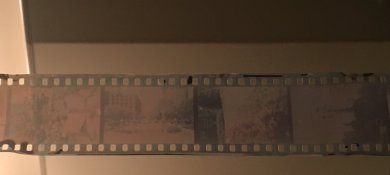Also, if anyone wants to experiment further with this process (especially with expired and less than ideal film), I'm super curious about if you can stand or semi-stand develop this stuff to get significantly more exposure latitude than standard E-6 processing. High contrast is good for projecting, but since we live in 2018, anything that works for scanning should suffice. Already even with this process as is, if scanning is the only thing you care about you can get some crazy latitude.
Here is a raw scan to show what I'm talking about:

Other than that white highlight, the entire frame looked pitch black to the naked eye, even with a bright backlight. However, scanning this with my DSLR for around 6s at f/11 and ISO 100 resulted in this incredible amount of detail out of something so underexposed. This was with Velvia 50 film in a Pen EES-2 camera. So it was taken inside on a cloudy day, under tungsten lights, using f/2.8 and 1/40s shutter speed. Estimating it in my house results in an effective ISO somewhere around 1200 and 2400. That's effectively 5 stops of shadow latitude. Of course, scanning this and getting any kind of quality out is very difficult at this level, but I think pushing the film to 2 or 3 stops would make decently usable images without any process change (ie, push in camera, not in development).. and in fact, I have a roll of 400 ISO C-41 where I mostly guessed at the exposure in low light that I processed this way and it came out with more shadow detail than I get with typical C-41 pushing.
The thing that makes this really difficult though is contrast. It's really difficult to scan these super dark shadows when you have completely clear highlights surrounding it. My DSLR just gets too much bloom to make it look good. I'm sure a pro scanner could probably do it, but I don't have one. So, my goal for creating an ideal "super push" process with this would be to severely restrict agitation in first developer, to try to prevent the highlights from going clear.. but ensure to develop long enough for the shadows to be as developed as possible. The difficult part is ensuring B/W developer penetrates all layers of the film (so it needs to be hot and not super diluted). After color processing, ideally you should be left with a significantly lower contrast positive that has maybe too dark of shadows to see with the naked eye, but that can be recovered in scanning, and with highlights that still have some detail and aren't completely clear.
From my experience so far, this process increases contrast on both E-6 and C-41 film, but E-6 film is naturally very high contrast. So I think if you can live with weird color crossing, You could potentially take stuff like Portra 400, shoot at 200 all the way up to 6400 and still get reasonable images. It's a real shame there isn't any high speed slide film being produced anymore. I'd love to try this with some Provia 400x








